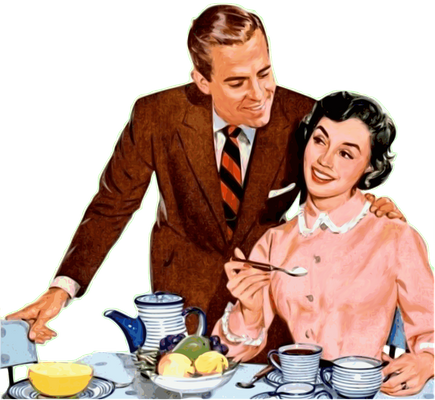4.1.4
Role & Status of Women in the FRG
Conservative Attitudes Towards Women in the FRG
Conservative Attitudes Towards Women in the FRG
The CDU espoused a conservative vision of the family. A woman’s primary purpose was to be a wife and mother.


The Basic Law
The Basic Law
- The FRG’s constitution guaranteed sexual equality.


The 'Woman Standing Alone’
The 'Woman Standing Alone’
- Following the death of so many soldiers, in 1950, one third of families were led by women.
- To fulfil the wifely ideal, widows were expected to look after their children.
- The woman standing alone was considered problematic in the eyes of the state.
- This was because the state was obsessed with the ‘full family’.


Housewives
Housewives
- Moeller (1993): Adenauer and the CDU promoted traditional marriage and placed it at the centre of society.
- If women wanted economic security, they were expected to marry, not work.
- It would not be until 1977 that the Family Law Book removed its final sentence, which stated it was the woman’s role to look after the home and family.
Women in the Workplace in the FRG
Women in the Workplace in the FRG
Despite CDU rhetoric which emphasised women’s place in the home, the economy demanded that women were employed.


Labour shortages
Labour shortages
- After WW2, labour shortages meant that women needed to work.
- Between 1949 and 1989, female employment increased.


Equal rights
Equal rights
- Women did not earn equal wages to men.
- On average, women received between 65-78% of a man’s wage for the exact same work.


Nature of women’s jobs
Nature of women’s jobs
- Female jobs conformed to the sexual division of labour.
- E.g. women were mostly in caring and nursing.


Women in politics
Women in politics
- In West Germany, politics was still a male arena.
- In the first Bundestag, 7% of representatives were female.
Sexual Rights of Women in the FRG
Sexual Rights of Women in the FRG
From the 1960s, women steadily began to gain greater autonomy over their bodies. This was partly driven by the new feminist movement.


Feminism
Feminism
- The 1960s saw the rise of a feminist movement across the west.
- This was a strong social and cultural force.
- The feminist movement strove to make the private political.
- Feminists called for intellectual respect, equal pay and greater welfare support for mothers.


Contraception
Contraception
- The pill became accessible in the 1960s.
- In 1964 2,000 women in the FRG used the pill. In 1968, 1.4 million used the pill.
- In 1976, the government legalised abortion.


Divorce
Divorce
- In 1977, the FRG passed legislation which allowed no-fault divorce.
1Political & Governmental Change, 1918-1989
1.1Creation & Collapse of Weimar, 1918-1932
1.2Nazi Dictatorship, 1933-1945
1.3Return to Democratic Government, 1945-1989
2Opposition, Control & Consent 1918-1989
2.1Opposition to Government, 1918-1989
2.2Controlling the People, 1918-1989
3Economic Developments & Policies, 1918-1989
3.1Reacting to Economic Challenges, 1918-1932
3.2Controlling the Economy, 1933-1945
3.3Creating the Social Market Economy, 1945-1989
4Aspects of Life, 1918-1989
4.1Attitudes Towards Women, 1918-1989
4.2Education & Cultural Developments, 1918-1989
5Historical Interpretations
5.1Influence of German History
5.2Hitler & Foreign Policy
5.3Contribution of Other Nations to WW2
5.4Reasons for Invading Poland
Jump to other topics
1Political & Governmental Change, 1918-1989
1.1Creation & Collapse of Weimar, 1918-1932
1.2Nazi Dictatorship, 1933-1945
1.3Return to Democratic Government, 1945-1989
2Opposition, Control & Consent 1918-1989
2.1Opposition to Government, 1918-1989
2.2Controlling the People, 1918-1989
3Economic Developments & Policies, 1918-1989
3.1Reacting to Economic Challenges, 1918-1932
3.2Controlling the Economy, 1933-1945
3.3Creating the Social Market Economy, 1945-1989
4Aspects of Life, 1918-1989
4.1Attitudes Towards Women, 1918-1989
4.2Education & Cultural Developments, 1918-1989
5Historical Interpretations
5.1Influence of German History
5.2Hitler & Foreign Policy
5.3Contribution of Other Nations to WW2
5.4Reasons for Invading Poland
Unlock your full potential with Seneca Premium
Unlimited access to 10,000+ open-ended exam questions
Mini-mock exams based on your study history
Unlock 800+ premium courses & e-books